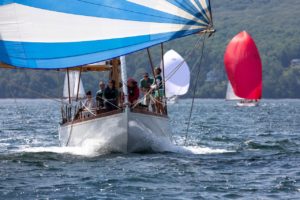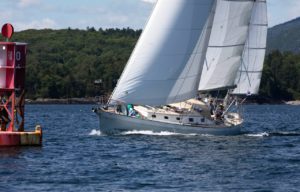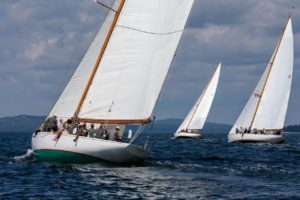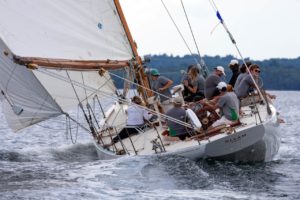
What the Maine sailing season lacks in length it makes up for in fantastic experiences. Whether cruising or racing, the icy waters, semi-reliable sea breezes, exotic thunderstorms, and sure, even the fog, create an otherworldly environment for those lucky enough to spend time amid the unlimited islands, rivers, and thoroughfares stretching along the Maine coast. Arguably the best time for sailing in Maine is the end of July through mid-September and if you’re up for a bit of sport, two key events are the Camden Classics Cup (July 29-31, www.camdenclassicscup.com) and the Eggemoggin Reach Regatta (Aug. 7, www.erregatta.com). There are other great events during the summer but these two had one key component in common for us this summer–Zingara was in the chase.
We’ve written a couple of pieces about Zingara becoming a member of the Stephens Waring family so wanted to share the latest on her growth and her interaction with others at two great sailing events. Zingara will be used in a way most sailboats are used for, providing a comfortable sea-worthy home away from home for her crew. Zingara excels at this responsibility. With cruising her primary occupation, some racing in Spirit of Tradition (SoT) design classes allows her to stretch her legs in competition. For us, success is measured in fun and camaraderie which keeps classic and SoT sailing a fantastic venue to strut both beauty and speed without undue pressure. That said, a bit of white-knuckling on the starting line and mark roundings is tough to avoid as a desire for success can slip ahead of a high fun factor if care is not observed.
Here we learn from Bob Stephens and Paul Waring about the fun of owning a cool boat in a great location and sailing at two excellent events.
How was the turnout for the events this summer?
Stephens: The turnout was excellent! The Camden Classics Cup saw ninety boats enrolled, continuing its growth since its founding, and up about 20 percent over 2019 (2020 was canceled due to Covid). Of those, about 40 percent were non-classic vessels, racing in PHRF or one-design. I love the inclusivity of the event, that it draws from all sorts of sailors and offers the opportunity for all to be on the water in the company of these gorgeous historical pieces that are classic yachts. And the Eggemoggin Reach Regatta was at near-record levels, with more than 110 boats.
Try to explain the fun of racing in mid-summer Maine.
Stephens: The first day of the Camden Classics Cup was classic Maine racing. With racing scheduled to start at noon, the wind was blowing straight up and down the mast at 11:55. After a postponement, at 1:00, we could see a small northwest zephyr on the water a half-mile north of the start line, and a tiny whisper of a southerly sea breeze a half-mile to the south. Sailboats were on the edge of each patch, sailing directly at each other, both running free. We were in the middle, between the light wind patches, with 0.0 knots of windspeed on the gauge. At 1:10 the race committee announced an elaborate 16-mile course for the SoT classes and it was a “what are they thinking?!” moment for sure. At the five-minute warning for the first start, however, it was like someone switched on a fan—the northwesterly filled in at 10 knots, all classes got off nicely, and within 15 minutes we were rail-down in a blustery, shifty, 20-25-knot nor’wester dropping down off the Camden hills among gorgeous white-and-dark cumulus clouds. That was the story for the rest of the day—fantastic energetic sailing under dramatic skies and scenery.
Waring: The very fact that we now have two great event series running back-to-back is a huge opportunity for people considering how they might spend a two-week window cruising their boats in Maine or traveling to Maine from destinations south or north (or East) of us. The thing that excites us about being involved in a regatta like the Camden Classics Cup (Stephens Waring Design is a founding regatta sponsor) is the way in which we’ve created our mission to organize the fleet, to find appropriate class breaks for all our entrants, and to design racing courses that are exciting to sail and extremely safe in which to participate in such a large and varied fleet. That makes this regatta series a huge success for a big-tent regatta. The Camden Classics Cup, with the race series and Eggemoggin Reach Regatta during the following week, offers a great destination for cruisers and locals to find things to do, both onboard and onshore should the goal be some decent racing competition mixed with fun social engagements. It’s really quite a pleasurable experience.

Zingara, owned by Stephens Waring Design principals, Bob Stephens and Paul Waring, sets up for a port rounding during the Camden Classics Cup. Bob and Paul worked on the design and lead the construction of Zingara when she was built by their employer, at the time, Brooklin Boat Yard, twenty years ago. ©Alison Langley
Over the regatta series did you see many new Spirit of Tradition entrants?
Stephens: One of the cool things that are happening with the widening of the Spirit of Tradition definition is the slow recognition of owners of composite boats with classic influences that they can qualify for SoT races. In the Camden Classics Cup, we were joined by two fiberglass boats that fill the bill nicely—Windwalker, a 60-foot Hood design, and Verissimo, an Alden design built by Goetz, which ended up winning the division.
Waring: We’re always looking for new participants. Because we’ve helped broaden the scope of boats that fit into the SoT narrative, we certainly welcome anyone to bring their SoT boat into the regatta and we encourage other regattas to make this effort, as well. Big tent, that’s the goal.
How many Stephens Waring designs were out racing over the multiple events?
Stephens: Boats with Stephens Waring DNA were plentiful in the Maine racing scene. Some dated from our time as in-house designers at Brooklin Boat Yard, and some have benefitted from their owners’ continued involvement with us over the years. A good example is Senshin, the smallest boat in the SoT fleet at the Camden Classics Cup, and a fun competitor for Zingara over the Camden-Brooklin Race and the Eggemoggin Reach Regatta, too. She was penned by Joel White, with me as his assistant designer, and also project boss on her construction in 1996. In 2019 her current owner asked Stephens Waring to update the underbody with a new keel and rudder, and he now describes her as an entirely new boat. The venerable Eggemoggin Reach Regatta’s SoT class was won by a hull I drew while at Brooklin Boat Yard; Lynnette is an Eggemoggin 47, an evolution of Lena, built in 2001. And second place was taken by Hoi An, a 50-footer drawn in 2002, outpacing several much newer boats of more radical design.

If not for the multitude of baseball caps and T-shirts this picture could have been taken in another era. Beauty with good design and construction is everlasting. Also everlasting is that good sails, boat preparation, tactics, and sail trim win races. ©Alison Langley
Was it fun to be racing your own boat and how was it different from crewing with customers?
Stephens: It was definitely fun to be racing Zingara. The big difference is in taking full responsibility for running the boat—deciding roles for the team, managing all aspects of logistics. More work than just showing up on the dock, but very satisfying. Still, I missed sailing with folks who have become friends, not just customers. Especially when they placed ahead of us!
Waring: We love sailing with clients and owners of our boats. We also really enjoy sailing with friends aboard their boats. Sailing together is a really great relationship builder and the shared experiences make for great memories; lots of opportunities for sailing, that’s for sure. Nothing quite beats having autonomy with our own program. We had a lot of fun this year with that and I look forward to years to come.
What are your racing histories?
Stephens: I didn’t begin racing with any seriousness until I was thirty, in the classic races like Eggemoggin Reach Regatta and others. I began racing with Steve White on Vortex as a regular crew in the early nineties and learned most of what I know with that team. I’ve sailed with clients frequently as well, and done several longer offshore races including three Bermuda Races. Still, if I race more than half a dozen races a year, I feel like I’ve raced a lot.
Waring: I grew up on the west coast, and as a kid, I enjoyed sailing with my father doing a few races each year that were shorter offshore races up to and down the coast in between our extended family cruises. Also, some club racing in the bay where we lived. Over the decades I’ve done many long-distance races, but not a whole lot of “round-the-buoys” racing. I like the strategy of starts and I enjoy much of the tactical decisions involved, and I love steering and trimming. But I’m not out looking to do all the racing I can fit into a season. As much as I love the teamwork aspects of sailing with good friends, for me sailing is more about getting away from everything, spending quality time with my wife, and connecting with the outdoors—enjoying life on the water.

The 12-Metre Gleam, pictured here, won the Vintage 1 Class at this year’s Camden Classics Cup. Congrats to the owner and crew and thanks for keeping such a beautiful example of the class in top sailing form. ©Alison Langley
What changes in equipment or tuning have you made since launching Zingara earlier this summer?
Stephens: We truly have not worked hard to tune her for speed—time aboard has been scarcer than we would like, and racing is only a part of her mission. Getting to know her, her strengths and weaknesses, has been more effective at coaxing speed out of her than tweaks to the rig and rigging. So far, the only change we have made to deck gear has been to add fairleads to improve the lead angle of the jib sheets onto the primary winches to reduce the likelihood of overrides.
Waring: I’ve spent a decent amount of time sailing Zingara short-handed this season and in a swath of conditions ranging from 4 to 10 kts up to 30 to 35 knots of wind. The boat is balanced, hugely stable, is quite comfortable, and handles a variety of conditions very well. This was the goal 20 years ago, and that is what I expected from her. She is not powered up to be a Grand-Prix racing yacht but was designed with a conservative amount of sail for solid performance over a range of conditions while cruising. With her split rig tuned to rig manufacturer specs, it largely meets expectations for this mission. Sailing this summer has given us plenty to contemplate for changing up details with deck hardware (among other things) but time to ruminate and set goals will be balanced by budget and our aims to focus our mission with the boat — so it’ll take time to process some decisions.
Does she sail the way you hoped that she would? What are her great characteristics? What are some challenging characteristics?
Stephens: She revels in stronger breezes, and has great power and stability. That said, I have been impressed with her ability to coast along in lighter breezes, too—at least when daysailing, not racing! In anything more than about eight knots, she is quick and very well-mannered. Under that threshold, things get sticky, real fast, with her current rig and sails.
Waring: Zingara is fairly sticky in light air, again she is not overly powered to accommodate light air sailing like some of our thoroughbreds. Back in our days with Brooklin Boat Yard, as project manager and designer I launched the boat 20 years ago, we immediately appreciated the ease of handling and the kind sailing she presents to her crew, this was important to our client. Her well-balanced hull shape and easy underbody also support those expectations–we have a well-appointed and comfortable cruising platform. Of the most challenging details to manage and bother with is her mizzen. It’s small and not very useful in conditions above 12 knots, and more importantly, I’ve always found little mizzens to be terribly difficult to deploy and take down…not exactly my cup of tea, I suppose.
What sails will you re-cut, re-design, or acquire?
Stephens: The gennaker that came with the boat is a good cruising chute, but way too small and flat to move Zingara in racing conditions. So we need a replacement for that, rather urgently. Eventually, we may make large changes to the rig, and those may include abandoning the mizzen mast—there’s a lot of windage there for the drive that sail produces, and although the mizzen staysail is fun, it is a lot of fuss too.
Waring: Probably the big limit to our ability upwind is the cut of our jib as a high-cut cruising shape for easy visibility. Something that maximizes the foretriangle a little more would be worth contemplating. I have a feeling we’ll be doing some soul-searching over the next year or two about just what we want out of the rig, and how we achieve that by modifying what we have. One way to consider adding sail area, for instance, is to give the mizzen a boot and re-tune the staying pattern of our current mast so we can alter the main to become a square-headed and much larger more efficient sail shape. This, with a proper working jib, would be very attractive for handling and performance…and, it would be a ton of fun to do!
Always a dodgy but fun question, who is the better driver? Tactician? Navigator?
Waring: I think it’s very difficult to answer this in any quantifiable way. We’re both very capable of handling all these duties on a boat. We’ve each nailed great starts this year, we’ve had great windward and leeward legs, yet I think our fluid trading of tactical information, sail trim, and helming responsibility makes things quite flexible and enjoyable for each of us. Again, the fun for us is found mostly in creating the best teamwork. We only race a few days out of the year and because we’re together we tend to operate the boat as a team and do what we can to support the other no matter the role. One of the strong points of our relationship as business partners is that we are good friends who care about each other and about how we convey that to people around us. Sailing together is a wonderful extension of how we work together day in and day out.